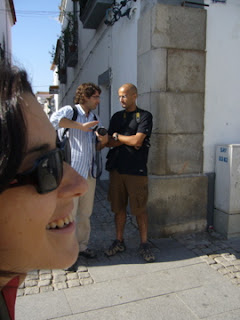We arrived in Beja by 9:30am where we met up with Pedro, our local tour guide. Our first scenic stop was Serpa. Beautiful city and became my favorite spot in Portugal.










Views from castle #1




What is site seeing without a taste of the local alcohol? Serpa is known for its "dirty beer" which is an age old technique of serving beer, in this case Sagres, in glasses that are washed with the least amount of care possible. This unique process leaves behind residue in the glass which somehow increases the amount of carbonation the beer contains once in the glass. As long as you do not scrutinize the black schmegma adhearing to the insides of the glass too much, it is really nice tasting beer. You have to admit, that is one bubbly brew...


Then we were off to Ameira (home to the largest bull fighting ring in the region) for our black pig lunch where we met up with Cristina. Pedro's restaurant serves the pig grilled as secretos de porco preto, which I like to refer to as 'little pork secrets' or 'my little pork secrets' if I am feeling particularly nostalgic. This lunch definitely stirred up some nostalgia. The Portuguese have a great talent for infusing any meat or fish item with copious amounts of salt in a very non-offensive way. The pork arrived on trays, charred and salty. Rita and fought for the most singed bits and we were off!




























And again, what is any traditional Portuguese meal without the corresponding traditional Portuguese drink? Look at their facial expressions as they cajoule me to try Bagaso, the fermented leftovers from the wine-making process, which is served from your very own mini wooden barrel...so conniving.


We sluggishly rolled out of Ameira to drive 35 km south to Monsaraz, an elevated white walled village with an amazing view. Monsaraz immediately replaced Serpa as my favorite Portuguese village. It had the advantage of having a castle that had been turned into a bull fighting ring, which was just cool to stand in.


















By sunset we arrived at the Monte do Limpo winery that had a beautiful view of Monsaraz and had a tasting menu made up of 4 really nice wines. Contrary to CA, wines Portuguese wines are commonly blends of several varietals so I am really confused about what we drank exactly. We each bought a bottle or two of the 2004 reserve red blend (Trincadeira, Aragonês, Alicante Bouschet, Syrah, Tinta Caiada). It was a marathon way to end the day.
















